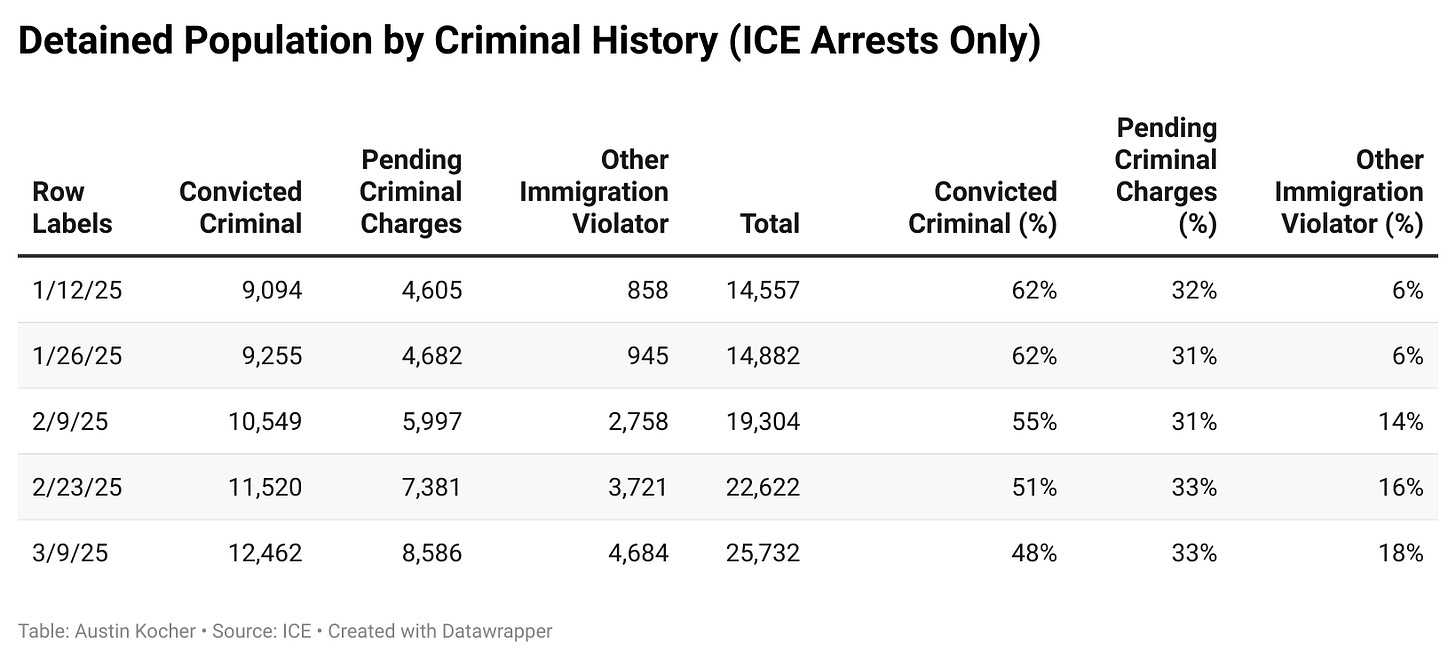Immigrant Detention Numbers Now Highest in Five Years, $430M in New Funding Likely to Fuel Further Growth
The latest ICE data show that over 46,000 immigrants are now held in detention. This finding comes just as Congress approves $430 million in new funding for detention and deportation.
ICE’s latest detention data released late Friday night shows that Immigration and Customs Enforcement (ICE) held 46,269 immigrants in custody in detention centers across the country as of March 9. This is a significant increase from January 12, when the last detention numbers under the Biden administration reached 39,703. The last time detention numbers were higher than they are now was on October 26, 2019, prior to the COVID-19 pandemic, when ICE reported holding 49,419 people in detention.
The spike in detention numbers is fueled entirely by increases in ICE’s interior enforcement efforts. Around 55 percent of immigrants in detention right now were arrested by ICE rather than CBP. ICE booked 17,375 people into detention centers in the month of February, up from nearly 12,000 in January and an average of 8,000 for the final three months of 2024.
The number of immigrants in detention as a result of border enforcement continues to decline, reflecting the larger fact that border apprehensions overall have dropped in absolute numbers in February. CBP booked 15,000 immigrants into ICE detention in October 2024, but this declined to almost 4,000 in February.
When the data on ICE and CBP enforcement is understood together, this represents a massive shift in where immigration enforcement is happening in the country. With fewer migrants coming across the border, the Trump administration is now focusing its enforcement efforts on immigrants in communities across the United States.
The graph below shows the detained population by arresting agency since July 2024 to emphasize this recent and quite sudden shift.
This new data came out on the same day that Congress allocated an additional $430 million on top of existing funds to expand immigration enforcement, including detention and deportation. ICE’s current detention numbers are not as high as the heights of the first Trump administration, when daily detention numbers reached over 60,000—but they could get there this year thanks to this new influx of Congressional funding.
As the American Immigration Council notes, Congress’s increase in enforcement funding does not include proportional increases in funding for the immigration court system, which undoubtedly shares the burden of heightened enforcement. This historic asymmetry in funding is one of the main reasons why the immigration court faces a nearly 4 million case backlog. We simply cannot allow politicians to continue to complain about the court backlog while their own funding decisions exacerbate the problem.
Trump’s border czar Thomas Homan has promised to expand immigrant detention. He called for 100,000 beds, which would more than double the agency’s current capacity. Although it won’t happen immediately, ICE could well get there during the Trump administration if Republicans and Democrats in Congress continue to work together to comply with ICE’s requests for additional funding.
ICE’s decision to restart family detention will also contribute to even more growth in detention numbers, since the family detention center Dilley, Texas, is the largest facility in the country with 2,400 beds alone. The family detention center is owned and operated by CoreCivic, a private contractor, which projects a “significant growth” in revenue in government contracts during the Trump administration.
The fraction of immigrants in detention who have no criminal history continues to grow as a percentage of all detainees, but all three of ICE’s categories of criminal history (conviction, charge, and none) have increased.
Just a reminder that this newsletter is only possible because of your support. If you believe in keeping this work free and open to the public, consider becoming a paid subscriber. You can read more about the mission and focus of this newsletter and learn why, after three years, I finally decided to offer a paid option. If you already support this newsletter financially, thank you.







Imagine the potential if we redirected resources towards building a more just and effective immigration system. By investing in our courts and judges, we could create a process that respects the rights and contributions of hardworking, taxpaying immigrants. This approach offers a pathway towards a more humane and productive resolution, rather than relying on detention
Thanks for keeping on top of these numbers. When you think of how companies like CoreCivic are profiting immensely off imprisoning innocent people whose sole "crime" is being an immigrant, it really makes you realize what a lie "freedom and democracy" is in the US.